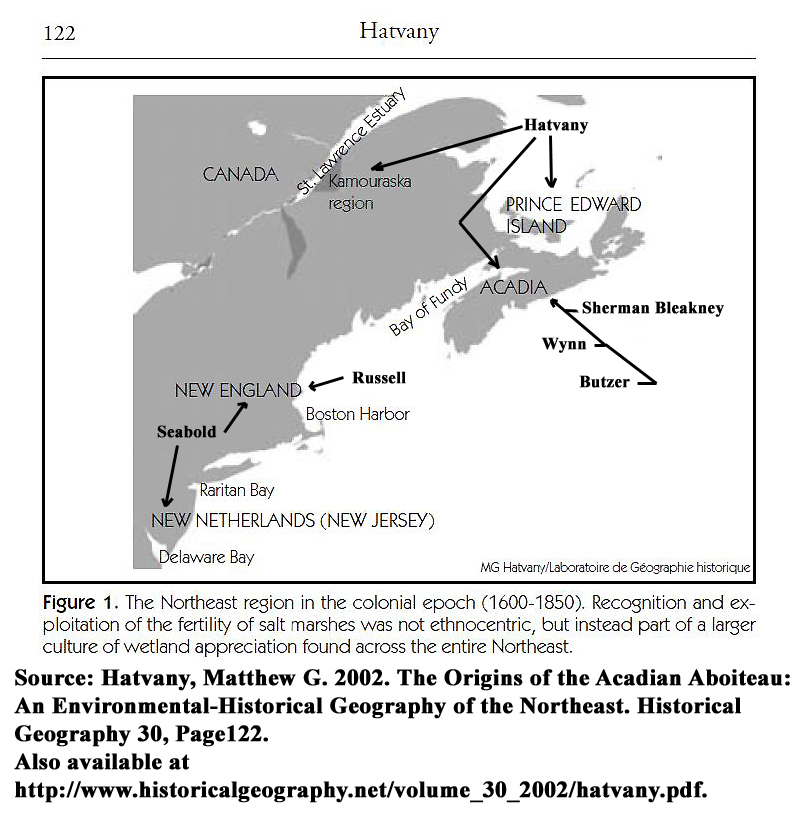The salt marshes on the Upper Bay of Fundy are part of a larger coastal area that developed when ice sheets, formed during the last ice age, retreated. The area is called the Glaciated Coast (Sebold 1992, Chapter 2) and extends from the St. Lawrence River south to the northern edge of New Jersey. The salt marshes on the Glaciated Coast were formed over the last six thousand years (Amos, 1978, P 965-981,Atlantic Geoscience Society 2001 and Gulf of Maine Council on the Marine Enviroment. 2008).
Another term for the Glaciated Coast is defined by Dr. Matthew G. Hatvany, a Université Laval Historical Geography Professor researching the human use of tidal wetlands. Professor Hatvany's definition is “The Northeast Region in the Colonial Epoch (1600-1850)”. Fig.1 is Professor Hatvany's map of the The Northeast Region. The names of several major researchers and their areas of investigation have been added to Fig.1.

A significant number of New England's colonial settlers were farm families from Western Europe’s wetlands where they had practised marshland agriculture and had at least a rudimentary understanding of dyke (sea wall) and aboiteau (tide gate) construction. It is not surprising, therefore, to learn that when these early settlers (the progenitors of many of Nova Scotia's Planter and Loyalists settlers) arrived in North America they sought out places to settle that contained salt marshes.
Fig. 2, from A Long, Deep Furrow: Three Centuries of Farming in New England by Howard S. Russell, shows the location of New England’s main areas of marshland. The importance of the marshes to New England's colonial settlers is nicely expressed by Russell:
"All along the winding Massachusetts Bay shore, wherever salt grass caught the eye, exploring stockmen were petitioning the General Court to be allowed to set up townships. The adjoining upland might be only moderately fertile, even chiefly ledges and woods, yet cattlemen brought up amid England’s grassy vales and tidal marshes coveted the salt hay in the lowlands…Fresh-water marshes exhibited drawing power also." (Russell, 1976 p 47).
Scott W. Nixon also describes how inportant salt marshes were in the lives of early New Englander’s:
"Before the salt marshes were considered wastelands in need of “reclamation,” and even longer before they were elevated to the rank of a “sacred cow” in the environmental movement, the marshes were clearly, and intimately, a part of the early New Englander’s “life support system”. (Nixon, 1982 p 47)

Amos, C. L. (1978). The postglacial evolution of the Minas Basin, Nova Scotia-a sedimentological interpretation. Journal of Sedimentary Petrology 48 (3).
Bleakney, J. S. (2004). Sods, soil, and spades: the Acadians at Grand Pré and their dykeland legacy. Montreal: McGill-Queen's University Press.
Butzer, Karl W. (2002) French Wetland Agriculture in Atlantic Canada and Its European Roots: Different Avenues to Historical Diffusion. Annals of the Association of American Geographers 92, no. 3 .
Hatvany, Matthew G. (2002). The Origins of the Acadian Aboiteau: An Environmental-Historical Geography of the Northeast. Historical Geography 30, Also available at http://www.historical-geography.net/volume_30_2002/hatvany.pdf.
Nixon, Scott W. (1982). The Ecology of New England High Salt Marshes: A Community Profile. Fish and Wildlife Service, US Department of the Interior [cited 15 March 2011]. Available from http://www.nwrc.usgs.gov/techrpt/81-55.pdf. p 47
Russell, Howard S. (1976). A Long, Deep Furrow: Three Centuries of Farming in New England: University Press of New England, Hanover, N.H. .
Sebold, Kimberly R. (1992) FROM MARSH TO FARM: The Landscape Transformation of Coastal New Jersey. National Park Service, [cited 7 July 2010. Available from http://www.nps.gov/history/history/online_books/nj3/contents.htm.
Shaw, John , Amos, Carl L., Greenberg, David A. , O’Reilly, Charles T., Parrott, D. Russell, and Patton, Eric ,(2010).Catastrophic tidal expansion in the Bay of Fundy, Canada, Can. J. Earth Sci. 47: 1079–1091
Taylor, Peter H. (2008). Salt Marshes in the Gulf of Maine: Human Impacts, Habitat Restoration, and Long-term Change Analysis. Gulf of Maine Council on the Marine Environment. www.gulfofmaine.org/saltmarsh.
Wynn, Graeme. (1979) Late Eighteenth-Century Agriculture on the Bay of Fundy Marshlands. Acadiensis, Volume 8 Issue 2 [cited 15 March 2011. Available from http://www.google.ca/search?client=firefox-a&rls=org.mozilla%3Aen-US%3Aofficial&channel=s&hl=en&sour ce=hp&q=Late+Eighteenth-Century+Agriculture+on+the+Bay+of+Fundy+Marshlands&meta=&btnG=Google+Search.